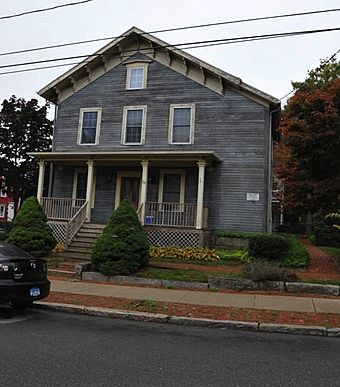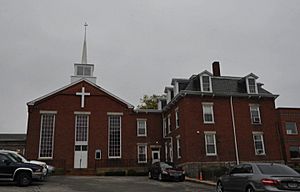Hempstead Historic District facts for kids
Quick facts for kids |
|
|
Hempstead Historic District
|
|
 |
|
| Location | Roughly bounded by Franklin Street, Jay Street and Mountain Avenue, New London, Connecticut |
|---|---|
| Area | 29 acres (12 ha) |
| Architect | Bishop, David; Et al. |
| Architectural style | Greek Revival, Italianate, Gothic Revival;Queen Anne |
| NRHP reference No. | 86002112 |
| Added to NRHP | July 31, 1986 |
The Hempstead Historic District is a special neighborhood in New London, Connecticut. It's a residential area located just north of the city's main harbor and downtown. This district includes three main streets: Franklin Street, Hempstead Street, and Mountain Avenue. The area has been settled since the 1600s. It shows how buildings and the city have changed over more than 300 years. This historic district was officially added to the National Register of Historic Places on July 31, 1986.
Contents
Discovering the Hempstead Historic District
This historic district is a fascinating place to explore. It covers about 29 acres, which is like 29 football fields! The district is home to 142 houses. Most of these homes were built between 1840 and 1920. They still look much like they did when they were first built.
A Look Back: Early Settlers
The Hempstead area was first settled way back in the 1600s. Two early settlers, Robert Hempstead and Nathaniel Holt, started farms here. Their farms overlooked a small bay called Bream Cove. One of the oldest buildings in New London is the Joshua Hempsted House. It's located at 11 Hempstead Street and was built in 1678. You can visit this house today, as it is a historic house museum. The Nathaniel Hempstead House, built in 1759, is also a museum open to the public.
Growing Up: The 19th Century Boom
The area didn't really start to grow a lot until the 1840s. At that time, New London's economy was booming because of the whaling industry. Whaling ships would bring in oil and other products, making the city very busy. This growth continued for about 100 years. Later in the 1800s, other industries also started to grow in the Hempstead area. This led to more people moving in, and the neighborhood became home to many free African American families.
Exploring the Streets and Buildings
The Hempstead Historic District has three main north-south roads: Franklin Street, Hempstead Street, and Mountain Avenue. It also has four east-west streets: Hempstead, Garvin, Home, and Jay Streets. The land here is quite hilly. Many properties have retaining walls, which make the area look like it has different levels or terraces.
Besides the many historic homes, there are other important buildings. One is the New London County Jail, built in 1845. It was designed in the Greek Revival style. Today, this building is the Shiloh Baptist Church. Another notable building is the Saltonstall School. It was built in 1903 in the Renaissance Revival style. These buildings show the different architectural styles popular during the district's growth.




